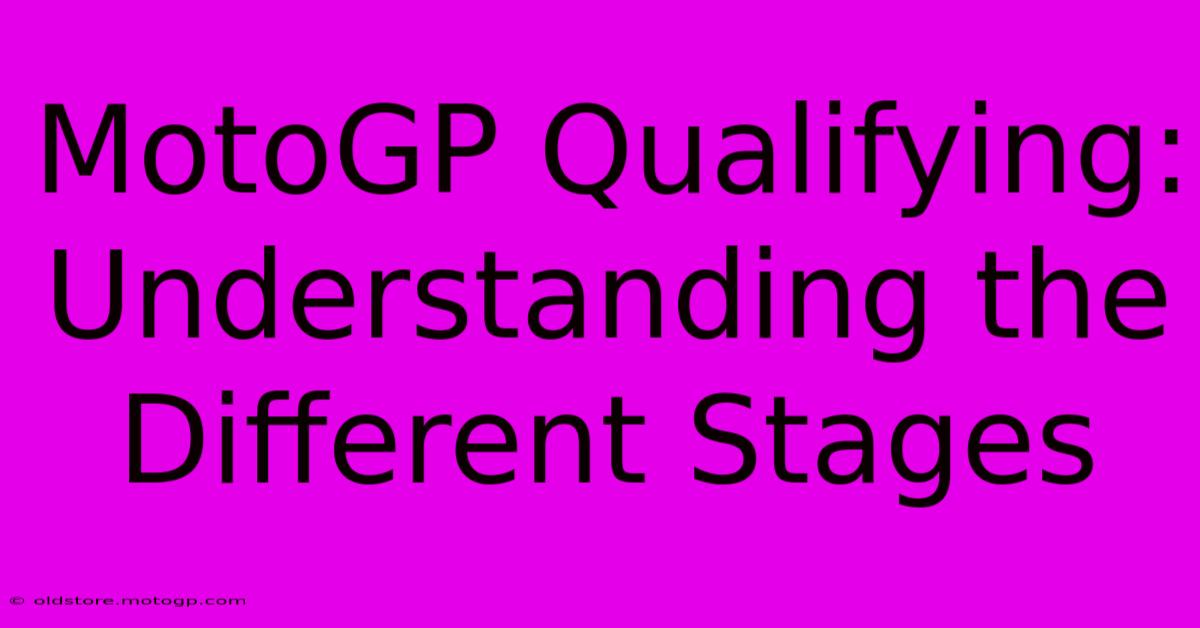MotoGP Qualifying: Understanding The Different Stages

Table of Contents
MotoGP Qualifying: Understanding the Different Stages
MotoGP qualifying is a crucial part of the weekend, setting the grid for the race and often dictating the outcome. But with its complex structure, understanding how it all works can be tricky. This guide breaks down the different stages of MotoGP qualifying, explaining the rules and the strategy behind them.
The Qualifying Format: A Breakdown
MotoGP qualifying is a multi-stage process designed to separate the fastest riders from the rest. The current format, introduced in recent years, involves two sessions: Q1 and Q2.
Q1: The Fight for Q2
Q1, the first qualifying session, is where the riders placed 11th to 20th in the combined Free Practice sessions (FP1, FP2, and FP3) battle it out. This is a high-stakes session, as only the top two riders from Q1 progress to the all-important Q2. The remaining riders will start the race from 13th to 20th on the grid. The pressure is intense, with riders pushing their machines to the absolute limit to secure a place in Q2. Strategic tire choices and race simulations are often employed here, adding another layer of complexity.
Key Considerations in Q1:
- Tire Management: Getting the most out of your tires without sacrificing performance is paramount.
- Track Conditions: Understanding how the track evolves throughout the session is critical.
- Slipstream: Utilizing the slipstream of other riders can provide crucial speed advantages.
Q2: The Showdown for Pole Position
Q2 features the top ten riders from the combined Free Practice sessions, along with the two fastest riders from Q1. This is the ultimate shootout, where the battle for pole position and the coveted front row spots takes place. The pressure is immense, with every tenth of a second crucial. The rider who posts the fastest lap time secures pole position, starting the race from the most advantageous spot on the grid.
Key Considerations in Q2:
- Perfect Laps: Consistency and executing the perfect lap are vital.
- Track Evolution: Analyzing the changing track conditions is paramount.
- Tire Choice: Selecting the optimal tire for a single fast lap is crucial.
- Slipstreaming: Effective slipstreaming can shave vital milliseconds off lap times.
Understanding the Strategy
The strategy employed during qualifying is as important as the raw speed. Teams meticulously analyze data from practice sessions to optimize tire selection, fuel loads, and race setups. They consider weather conditions, track temperature, and even the wind direction when formulating their qualifying approach.
Factors influencing qualifying strategy:
- Tire wear: Finding the balance between performance and tire degradation is critical.
- Weather: Changing weather conditions can significantly impact performance.
- Mechanical Issues: Dealing with potential mechanical problems swiftly is essential.
Beyond the Qualifying Sessions
While Q1 and Q2 are the main qualifying stages, there's more to consider. The combined results from Free Practice significantly influence the starting positions. A strong performance in Free Practice can secure a place in Q2, giving riders a significant advantage in the pursuit of pole position.
The Impact of Free Practice:
- Setting the Stage: Free Practice establishes the baseline performance and sets the stage for qualifying.
- Data Collection: Teams gather crucial data on tire performance, bike setup, and track conditions.
- Risk Management: Free Practice allows riders to test different setups and manage risk without jeopardizing their qualifying performance.
Conclusion: Mastering the Art of MotoGP Qualifying
MotoGP qualifying is a complex and multifaceted process demanding precision, skill, and strategic thinking from riders and their teams. Understanding the nuances of the Q1 and Q2 sessions, alongside the importance of Free Practice, is crucial to fully appreciating the intensity and drama of this critical stage of the MotoGP weekend. The fight for pole position is a spectacle in itself, a thrilling prelude to the main event.

Thank you for visiting our website wich cover about MotoGP Qualifying: Understanding The Different Stages. We hope the information provided has been useful to you. Feel free to contact us if you have any questions or need further assistance. See you next time and dont miss to bookmark.
Featured Posts
-
F1 Austin Discover The Citys Hidden Gems
Feb 25, 2025
-
Riding The Wind Moto Gp Aerodynamics And Rider Control
Feb 25, 2025
-
Experience The Excitement Cota Merchandise Collection
Feb 25, 2025
-
Understanding Austin F1 Qualifying
Feb 25, 2025
-
The Winning Formula Sting F1
Feb 25, 2025
